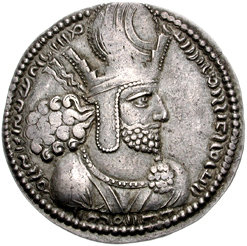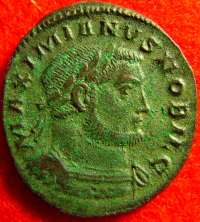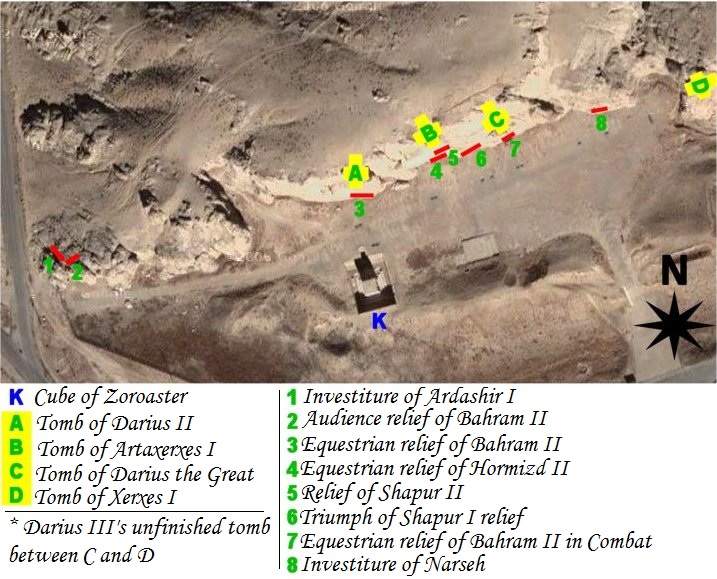|
Hormizd II Of Persia
Hormizd II (also spelled Hormozd or Ohrmazd; ) was king (shah) of the Sasanian Empire. He ruled for six years and five months, from 303 to 309. He was a son and successor of Narseh (). During his reign, the Kingdom of Armenia had recently declared Christianity as its official religion, thus leaving its ancient Zoroastrian heritage that it shared with Sasanian Iran. Hormizd II's reign was also marked by internal turmoil, which he successfully managed to deal with. Hormizd II was also successful in his efforts in the west, defeating and killing the Ghassanid king in Syria. His reign was, however, cut short by the intrigues of the Iranian nobility, who killed him in a secluded place. He was succeeded by his son Adur Narseh, who after a few months of reigning was also killed by the nobility. They instead installed Hormizd II's infant son Shapur II on the throne. Etymology The name of Hormizd (also spelled ''Ōhrmazd'', ''Hormozd'') is the Middle Persian version of the name of the ... [...More Info...] [...Related Items...] OR: [Wikipedia] [Google] [Baidu] |
King Of Kings Of Iranians And Non-Iranians
The House of Sasan, Sasanian monarchs were the rulers of Iran after their victory against their former suzerain, the Parthian Empire, at the Battle of Hormozdgan in 224. At its height, the Sasanian Empire spanned from Turkey and Rhodes in the west to Pakistan in the east, and also included territory in what is now the Caucasus, Yemen, UAE, Oman, Egypt, Palestine, Israel, Lebanon, Syria, Jordan and Central Asia. The Sasanian Empire was recognized as one of the main powers in the world alongside its neighboring arch rival, the Roman Empire for a period of more than 400 years.Norman A. Stillman ''The Jews of Arab Lands'' pp 22 Jewish Publication Society, 1979 International Congress of Byzantine Studies ''Proceedings of the 21st International Congress of Byzantine Studies, London, 21–26 August 2006, Volumes 1-3'' pp 29. Ashgate Pub Co, 30 sep. 2006 The Sasanian dynasty began with Ardashir I in 224, who was a Persian people, Persian from Istakhr, and ended with Yazdegerd III in 651. ... [...More Info...] [...Related Items...] OR: [Wikipedia] [Google] [Baidu] |
Middle Persian
Middle Persian, also known by its endonym Pārsīk or Pārsīg ( Inscriptional Pahlavi script: , Manichaean script: , Avestan script: ) in its later form, is a Western Middle Iranian language which became the literary language of the Sasanian Empire. For some time after the Sasanian collapse, Middle Persian continued to function as a prestige language. It descended from Old Persian, the language of the Achaemenid Empire and is the linguistic ancestor of Modern Persian, the official language of Iran (also known as Persia), Afghanistan ( Dari) and Tajikistan ( Tajik). Name "Middle Iranian" is the name given to the middle stage of development of the numerous Iranian languages and dialects. The middle stage of the Iranian languages begins around 450 BCE and ends around 650 CE. One of those Middle Iranian languages is Middle Persian, i.e. the middle stage of the language of the Persians, an Iranian people of Persia proper, which lies in the south-western Iran highlands on ... [...More Info...] [...Related Items...] OR: [Wikipedia] [Google] [Baidu] |
Peace Of Nisibis (299)
The Peace of Nisibis of 299, also known as the First Peace of Nisibis, was a peace treaty signed in 299 by the Roman and Sasanian empires, and concluded the Roman–Sasanian War of 296–299. The border established as a result of the treaty was maintained until the Second Peace of Nisibis of 363. The terms of the treaty are known from a 6th-century summary of its content by Peter the Patrician during the reign of Justinian I. Background During the Roman–Sasanian War of 296–299, despite earlier successes in Mesopotamia, the Sasanian Shah Narseh was defeated by the Roman Caesar Galerius in Armenia in two successive battles. In the second encounter, the Battle of Satala in 298, following their victory on the field, Roman forces seized Narseh's camp, his treasury, his harem, and his wife. Galerius continued south through Sasanian territory and captured the Sasanian capital, Ctesiphon, before returning to Roman territory. In 298, Narseh sent his ambassador Apharban to negotiat ... [...More Info...] [...Related Items...] OR: [Wikipedia] [Google] [Baidu] |
Battle Of Satala (298)
The Battle of Satala was fought in 298, in Kingdom of Armenia (antiquity), Armenia, between the forces of the Roman Empire under the Tetrarchy, Tetrarch Galerius and the forces of the Sasanian Empire, Sasanian Empire of Persia led by Shah Narseh (Narses). The battle was an overwhelming victory for the Late Roman army, Roman army, with the Persian army destroyed as a fighting force. The Romans obtained an enormous amount of plunder from the defeated Persians, and captured Narseh's principal wife. The campaign concluded with a very favourable peace treaty for Rome, with Persia ceding considerable territory. Location Though traditionally known as the Battle of Satala, the precise location of the battle is not known; the town of Satala may have served as the Roman base of operations. In an early Armenian history it is stated that the battle was fought in the region of Basean, at a village called Osxay. Basean (Phasiana) is usually placed to the east of Erzerum.History of the Armenian ... [...More Info...] [...Related Items...] OR: [Wikipedia] [Google] [Baidu] |
Roman Empire
The Roman Empire ruled the Mediterranean and much of Europe, Western Asia and North Africa. The Roman people, Romans conquered most of this during the Roman Republic, Republic, and it was ruled by emperors following Octavian's assumption of effective sole rule in 27 BC. The Western Roman Empire, western empire collapsed in 476 AD, but the Byzantine Empire, eastern empire lasted until the fall of Constantinople in 1453. By 100 BC, the city of Rome had expanded its rule from the Italian peninsula to most of the Mediterranean Sea, Mediterranean and beyond. However, it was severely destabilised by List of Roman civil wars and revolts, civil wars and political conflicts, which culminated in the Wars of Augustus, victory of Octavian over Mark Antony and Cleopatra at the Battle of Actium in 31 BC, and the subsequent conquest of the Ptolemaic Kingdom in Egypt. In 27 BC, the Roman Senate granted Octavian overarching military power () and the new title of ''Augustus (title), Augustus'' ... [...More Info...] [...Related Items...] OR: [Wikipedia] [Google] [Baidu] |
Protome
A protome ( Greek: προτομή) is a type of adornment that takes the form of the head and upper torso of either a human or an animal. History Protomes were often used to decorate ancient Greek architecture, sculpture, and pottery. Protomes were also used in Persian monuments. At Persepolis (ca. 521-465 BCE), an array of stone fluted Persian columns topped by bull protomes distinguish the great hall (apadana) where the king received guests numbering over 10,000. Protomes, combining several different animals are also found at the palace of Darius I, Susa, Iran. At his palace at Susa, pairs of complex protomes feature animals (mythic or real) known to be fierce or intimidating. These function symbolically and structurally: they symbolize power and cosmic balance, but they also support the beams of the ceiling structure. At Susa, the protome capitals form a socket that holds the roof beams in place. Many Protome are Terracotta mould-made busts of women that were representations ... [...More Info...] [...Related Items...] OR: [Wikipedia] [Google] [Baidu] |
Anahita
Anahita is the Old Persian form of the name of an Iranian goddess and appears in complete and earlier form as ('), the Avestan name of an Indo-Iranian cosmological figure venerated as the divinity of "the Waters" ( Aban) and hence associated with fertility, healing and wisdom. There is also a temple named Anahita in Iran. Aredvi Sura Anahita is ''Ardwisur Anahid'' (اردویسور آناهید) in Middle and Modern Persian, and '' Anahit'' in Armenian. An iconic shrine sects of Aredvi Sura Anahita was, together with other shrine sects, "introduced apparently in the 4th century BCE and lasted until it was suppressed in the wake of an iconoclastic movement under the Sasanids.". The symbol of goddess Anahita is the Lotus flower. Lotus Festival (Persian: Jashn-e Nilupar) is an Iranian festival that is held on the end of the first week of July. Holding this festival at this time was probably based on the blooming of lotus flowers at the beginning of summer. The Greek and R ... [...More Info...] [...Related Items...] OR: [Wikipedia] [Google] [Baidu] |
Naqsh-e Rostam
Naqsh-e Rostam (; , ) is an ancient archeological site and necropolis located about 13 km northwest of Persepolis, in Fars province, Iran. A collection of ancient Iranian rock reliefs are cut into the face of the mountain and the mountain contains the final resting place of four Achaemenid kings, notably king Darius the Great and his son, Xerxes. This site is of great significance to the history of Iran and to Iranians, as it contains various archeological sites carved into the rock wall through time for more than a millennium from the Elamites and Achaemenids to Sassanians. It lies a few hundred meters from Naqsh-e Rajab, with a further four Sassanid rock reliefs, three celebrating kings and one a high priest. Naqsh-e Rostam is the necropolis of the Achaemenid dynasty ( 550–330 BC), with four large tombs cut high into the cliff face. These have mainly architectural decoration, but the facades include large panels over the doorways, each very similar in conten ... [...More Info...] [...Related Items...] OR: [Wikipedia] [Google] [Baidu] |
Relief Of Hormizd II In Naqsh-e Rostam
Relief is a sculptural method in which the sculpted pieces remain attached to a solid background of the same material. The term ''relief'' is from the Latin verb , to raise (). To create a sculpture in relief is to give the impression that the sculpted material has been raised above the background plane. When a relief is carved into a flat surface of stone (relief sculpture) or wood (relief carving), the field is actually lowered, leaving the unsculpted areas seeming higher. The approach requires chiselling away of the background, which can be time-intensive. On the other hand, a relief saves forming the rear of a subject, and is less fragile and more securely fixed than a sculpture in the round, especially one of a standing figure where the ankles are a potential weak point, particularly in stone. In other materials such as metal, clay, plaster stucco, ceramics or papier-mâché the form can be simply added to or raised up from the background. Monumental bronze reliefs are ma ... [...More Info...] [...Related Items...] OR: [Wikipedia] [Google] [Baidu] |
Georgian Language
Georgian (, ) is the most widely spoken Kartvelian language, Kartvelian language family. It is the official language of Georgia (country), Georgia and the native or primary language of 88% of its population. It also serves as the literary language or lingua franca for speakers of related languages. Its speakers today amount to approximately 3.8 million. Georgian is written with its own unique Georgian scripts, alphabet, alphabetical systems of unclear origin. Georgian is most closely related to the Zan languages (Megrelian and Laz language, Laz) and more distantly to Svan language, Svan. Georgian has various dialects, with standard Georgian based on the Kartlian dialect, and all dialects are mutually intelligible. The history of Georgian spans from Early Old Georgian in the 5th century, to Modern Georgian today. Its development as a written language began with the Christianization of Georgia in the 4th century. Georgian phonology features a rich consonant system, including aspi ... [...More Info...] [...Related Items...] OR: [Wikipedia] [Google] [Baidu] |
Armenian Language
Armenian (endonym: , , ) is an Indo-European languages, Indo-European language and the sole member of the independent branch of the Armenian language family. It is the native language of the Armenians, Armenian people and the official language of Armenia. Historically spoken in the Armenian highlands, today Armenian is also widely spoken throughout the Armenian diaspora. Armenian is written in its own writing system, the Armenian alphabet, introduced in 405 AD by Saint Mesrop Mashtots. The estimated number of Armenian speakers worldwide is between five and seven million. History Classification and origins Armenian is an independent branch of the Indo-European languages. It is of interest to linguists for its distinctive phonological changes within that family. Armenian exhibits Centum and satem languages, more satemization than centumization, although it is not classified as belonging to either of these subgroups. Some linguists tentatively conclude that Armenian, Greek ... [...More Info...] [...Related Items...] OR: [Wikipedia] [Google] [Baidu] |
Greek Language
Greek (, ; , ) is an Indo-European languages, Indo-European language, constituting an independent Hellenic languages, Hellenic branch within the Indo-European language family. It is native to Greece, Cyprus, Italy (in Calabria and Salento), southern Albania, and other regions of the Balkans, Caucasus, the Black Sea coast, Asia Minor, and the Eastern Mediterranean. It has the list of languages by first written accounts, longest documented history of any Indo-European language, spanning at least 3,400 years of written records. Its writing system is the Greek alphabet, which has been used for approximately 2,800 years; previously, Greek was recorded in writing systems such as Linear B and the Cypriot syllabary. The Greek language holds a very important place in the history of the Western world. Beginning with the epics of Homer, ancient Greek literature includes many works of lasting importance in the European canon. Greek is also the language in which many of the foundational texts ... [...More Info...] [...Related Items...] OR: [Wikipedia] [Google] [Baidu] |






